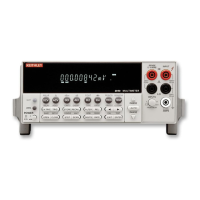Dry circuit testing
Many low resistance measurements are made on contact devices such as switches and relay
contacts. The purpose of these tests is to determine whether oxidation has increased the
resistance of the contacts. If the voltage across the contacts during the test is too high, the
oxidation will be punctured and render the test meaningless.
Dry circuit testing limits the voltage across the DUT to 20mV or less.
NOTE This function is only available in four-wire ohms.
Offset compensation
Offset compensation is used to compensate for voltage potential, such as thermal offsets,
across the device under test. In offset compensation, a full-scale source current is applied to the
resistance being measured during part of the measurement cycle. Figure 2-7 shows the measure-
ment cycle. During the first half of the measurement cycle, the reduced source current is applied
and the voltage being measured is any thermal EMFs present in the circuit plus the voltage
across R
S
with the reduced source current:
During the second half of the measurement cycle, the full-scale source current is on, and the
total voltage measured includes the voltage drop across the resistor and any thermal EMFs. This
is defined as follows:
Offset compensation is available up to 100MΩ. However, compensation is only being used
on the 10KΩ and lower ranges. An ’o’ will flash on the display if offset compensation is turned
on and measuring 100KΩ and higher ranges, indicating offset compensation has no effect.
Since the thermal EMF voltage is measured during the first and second half of the cycle, it
can be subtracted from the voltage measurement made during the first half of the cycle. The
result is the offset-compensated voltage measurement:
Therefore,
V
M2
V
EMF
I
SR
R
S
+=
V
M1
V
EMF
I
SFS
R
S
+=
V
M1
V
M2
– V=
M
V
EMF
I
SFS
R
S
+()V
EMF
I
SR
R
S
+()–=
V
M
R
S
I
SFS
I
SR
–()=
R
S
V
M
I
SFS
I
SR
–
-------------------------=
2-26 Basic Measurements

